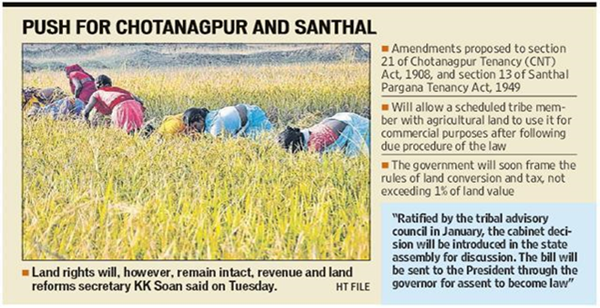

|
Overview
|
Context
A public interest litigation before the Supreme Court seeks changes in two decades-old laws that restrict the sale of tribal land to non-tribal.
Background
- Ownership and access to land and forests has been critical to the tribal peoples’ way of life as well, given the symbiotic relationship they share with jal, jungle, aur jaanvar(water, forests, and animals).
- In Jharkhand, there are two acts—the Chhota Nagpur Tenancy Act, and the Santhal Pargana Tenancy Act—which protect tribal peoples’ right to their land, and hence prohibit sale of their land to non-tribal populations.
- However, over the years, there have been amendments to these acts that have weakened the position of tribal people in rural areas, and haven’t helped those in urban areas either.
- At present, there are 64,000 litigations pending in the high court of Jharkhand, filed by tribal communities against these amendments.
Analysis
Existing Acts in India
Chhota-Nagpur Tennacy Act
- It restricts transfer of tribal land to non-tribals.
- The CNT Act is effective in North Chhota Nagpur, South Chhota Nagpur and Palamau divisions, including areas under various municipalities and notified area committees.
- So far, the CNT Act has been amended as many as 26 times, latest in 1995.
- It is listed in the Ninth Schedule of the Constitution, so the act is beyond judicial review.
- It can only be repealed by the Parliament; the state government can only make amendments to it.
- In 1962 the Bihar government amended the CNT Act to include "economically weaker castes (EWCs)" belonging to the SC and OBC.
- The original Act applied only to the lands of Scheduled tribes (STs) and vested the power of land transfer on the plea of the right owner, with the deputy commissioner (DC).
- It notified a list of backward classes, the sale of whose land would be restricted as per the CNT Act.
Issues with the Act
- No up-gradation of Land Rights:
- There is poor mirroring of land records with the actual position on the ground.
- Almost nine decades after the survey and settlement of Santhal Parganas in 1932, there is no authentic record of who is currently in possession of the land.
- In case of land disputes, the standard procedure is to look up the record of rights of 1932 and deduce through the genealogy of the original tenant who the rightful possessor is today.
- Illegal market of land:
- Forces of demand and supply have led to the creation of an illegal market for land transfers and these cannot be legitimately recorded.
- Fake documents:
- Fake documents by themselves are not a problem unique to Santhal Parganas.
- However, what makes it especially dangerous is the fact that government records are not updated enough.
- Revenue courts cannot question the validity of a deed and this creates a huge roadblock in deciding cases since both parties produce seemingly legitimate deeds for the same piece of land in areas where transfers are allowed.
- In the absence of the transactional history of a land parcel, it becomes extremely complicated to detect forged documents.
- Data generation:
- There are problems with the process of data generation. Land records modernization is a brilliant tool for improving land governance however there are some nuances that ought to be noted.
- Despite extensive digitisation, land records still mirror only a tiny proportion of the actual landholdings.
- Land mortagage:
- Tribals not being able to mortgage their land since banks do not give loans for these lands as collateral owing to the provisions of the laws.
- Exploitation and deprivation:
- The exclusion of division made exploitation of tribals in the region and even they are deprived of other governmental facilities.
- Underdevelopment and poverty:
- Government schemes for development works cannot be implemented in these areas, due to which these areas remain underdeveloped and poor.

|
Constitutional provisions Part X of the Constitution contains special provisions relating to administration of Scheduled Areas and tribal areas. Article 244 (1) of the Constitution:
The Scheduled Tribes and Other Traditional Forest Dwellers (Recognition of Forest Rights) Act, 2006:
|
Suggestive measures
- Amendments in the act governing forest and tribal rights in the region will help.
- Control in Corruption and Strict administrative authorities can save tribal rights and their exploitation.
- Involvement of Civil societies in educating tribals.
Conclusion
The acts were constituted in good faith and to protect the rights of the tribal peoples; however, urbanization has forced them to change their way of life to a certain extent. They are unable to unlock the potential of the land, and are being exploited by powerful elements—both within their community and outside of it. It might therefore be time to understand ground realities in greater detail, review existing provisions, and introduce amended laws that serve the interests of urban tribal peoples.
|
PRACTICE QUESTION: Q1) Discuss the important provisions of the Chota Nagpur Tenancy (CNT) Act? Do you think this act was able to prevent tribals land rights? Give suitable examples. Q2) Examine the relevance of the features of the Santhal Parganas Tenancy (Supplementary provisions) Act in preventing the local tribes from reclaiming their land. |

